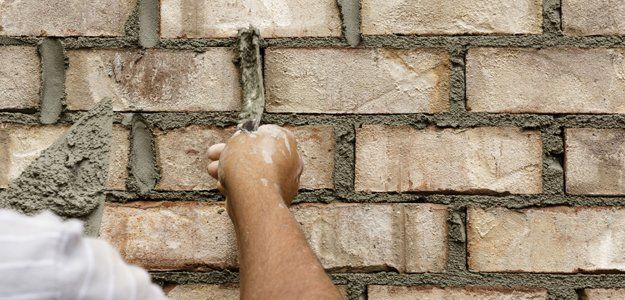When restoring historic brickwork it is critical to identify the composition of typically the original mortar utilized in the construction of the masonry structure. When this kind of might sound just like a suggestion and even an try to trade you on the thought, there are several factors the reason why you require to analyze the mortar in addition to ascertain the structure of the unique mortar used.
Older or historic brickwork units had been side made and tend being softer or even far more brittle than the really hard terminated clay bricks utilised in construction now, and stone can have distinct variant elements. Depending from the variety of stone, it will possess diverse crushing demands, and will demand a mortar that may be softer than typically the rock. This is definitely correct from the side created bricks likewise. Mortar must end up being softer than the brickwork unit being utilized to avoid damage to the stones or stones. This particular element carries over into mortars right now, but is normally overlooked by the particular builders of right now.
Every single mortar variety is primarily based on the variant variety of composition or compressive strength. An example of this is type n masonry cement ( which can be most usually employed now ) provides a compressive strength of 750 psi which is commonly made working with 1 aspect Portland cement mixed together with 1 to a single and a single quarter components lime and even about two plus a quarter to 3 components sand by volume., and a lime mortar has a compressive strength of about 75 psi.
The different sorts regarding mortar are lime green mortar, historic lime scale mortar (which consists of historic lime), variety k mortar, form o mortar, variety n mortar, variety s mortar, plus sort m mortar. And the crushing stress of these kinds of kinds of mortar are 75 pound-force per square inch (psi) for lime mortars, 150 psi for form k, 450 psi for form o, 750 pound-force per square inch for kind in, 1800 psi with regard to variety s, and even 2800 psi with regard to type m mortar.
As you can easily see, there is definitely a large distinction among every single mortar variety and may absolutely effect the final results involving any masonry fix.
Historic mortars tend to range by lime mortar upwards to form to mortar in part due to the price of Portland cement, but in addition to shield the particular masonry units. The lime employed was often slacked on place and tended to have significant items. This is known as historic lime. These substantial pieces would be the difference between historic lime and the type S/SA lime utilised nowadays which are processed through security to make sure smaller sized particles. The only true effect these kinds of pieces have in the mortar is definitely visibility. They transform the appearance involving the mortar color and texture.
Since there was typically a require to put strength towards the mortar, but not exceed the compressive power of the brickwork units, fibers were usually mixed in to the mortar. Typically the most common fibers used was horse locks. Horse hair and unique grasses had been also utilized to help make the bricks and hold them with each other.
In purchase to preserve historical masonry, a terrific package of attention have to be paid to the facts. To do this, you will have to first collect the facts accessible about the particular mortar and the masonry units. This particular demands testing regarding the hardened mortar and/or the bricks or stones.
By masonry contractors fort worth tx of mortar evaluation, you determine the mortar composition, compressive power of mortar, typically the kind of lime scale utilised, if fibres have been utilized, plus the type, color, and graded size particles of the fine sand made use of in the particular old mortar.
These are the essential facts to help make a matching mortar for repointing.
Now there are many fancy and often expensive testing approaches utilized in analyzing mortar samples of which just aren’t quite dependable. Some associated with these tests acquire pretty images with the mortar sample that will identify distinct elements of the mortar by colour. This picture is then looked at visually plus a most effective guess associated with the proportions happen to be determined. This technique has many limitations, and the most detrimental is the understanding, knowledge, and understanding associated with the technician examining the types of mortar. If they don’t recognize masonry, precisely how it is used, and how it is built, they can’t interpret the information accurately.

A prime instance of this is usually calcium, and this particular 1 carries over into numerous involving the mortar assessment solutions plus the outcomes becoming analyzed simply by chemists only. All through the industry, there is emphasis on the quantity regarding calcium in the particular mortar. This has extremely little regarding the mortar composition plus makes little to be able to no change inside the way the mortar performs.
You will uncover calcium mineral in the yellow sand in typically search for amounts, but many sands are higher in calcium compared to other folks. In this kind of usage the calcium mineral is vital. Nevertheless, the use associated with calcium added in order to mortar tells us more about the temperatures and weather conditions in the course of the time of construction.
Because lime mortars remedy, the lime takes as well as bonds with co2 which causes it to remedy and harden. Portland cement releases carbon dioxide as it heals. This tends to make these people function well together. Nonetheless, in cold weather, the chemical reaction of the Portland can slow or perhaps stop. When this particular happens, the mortar cures much more slowly and might not really let the Portland to incorporate strength by its reaction causing the mortar to be able to cure a calcium mortar. Calcium can be added to the particular mortar to raise the chemical reactions of the Portland and lime and even cause extra warmth. With the additional heat and the particular Portland putting away from co2 quickly, right now there is plenty of co2 for the particular line to attachment with and the mortar will cure even in frigid temperatures.
As a person can see, mortar evaluation is needed to be able to recognize the mortar composition, but typically the outcomes need in order to be interpreted by a person with knowledge and knowledge in masonry. This does not mean that you can rely solely about the expertise and expertise of just any mason. A person need the accurate testing data in order to get the formula of mortar with regard to masonry preservation. The particular understanding and use of that data can only end up being interpreted by a person with understanding in how it performs, and the suggestions for variance really should be created using this understanding.


